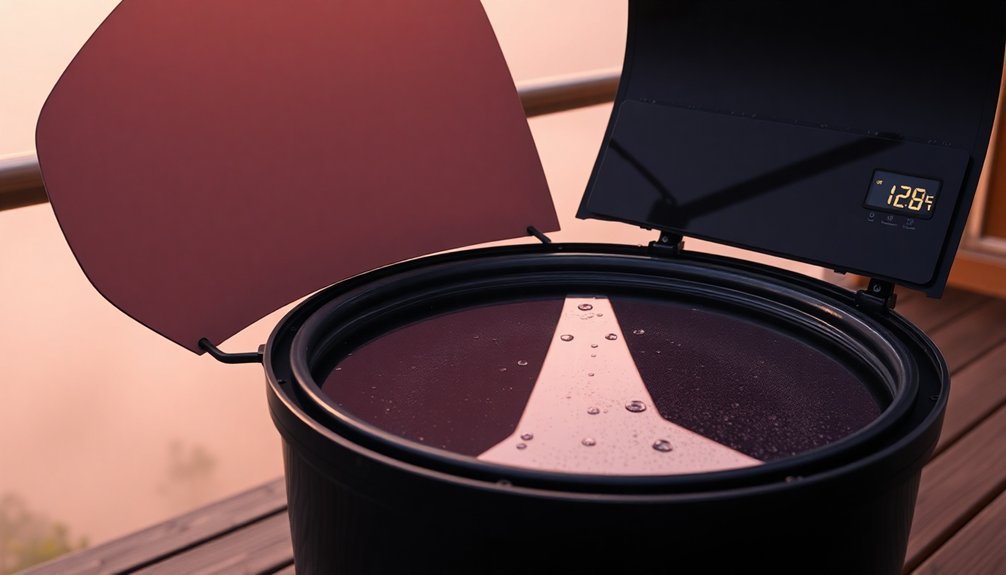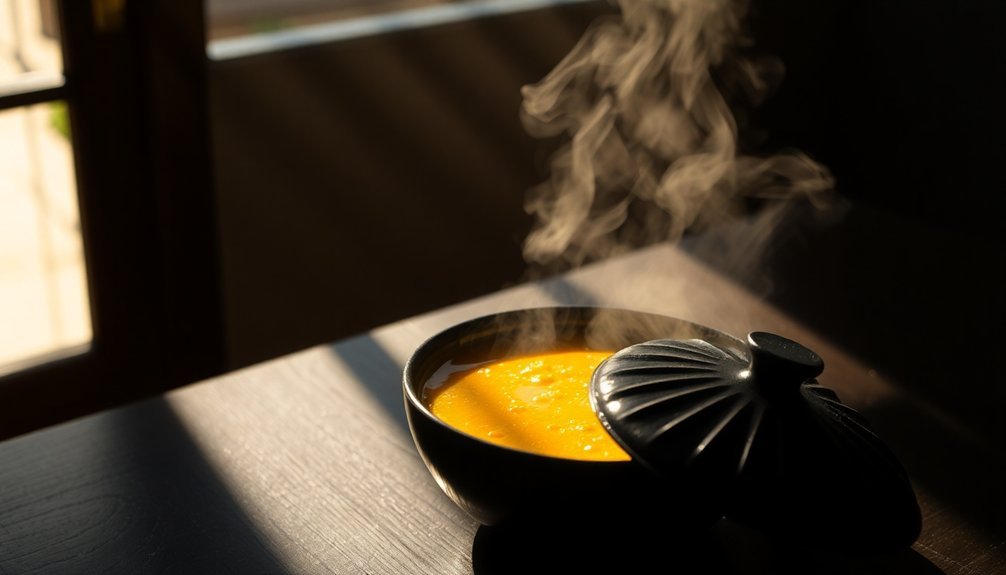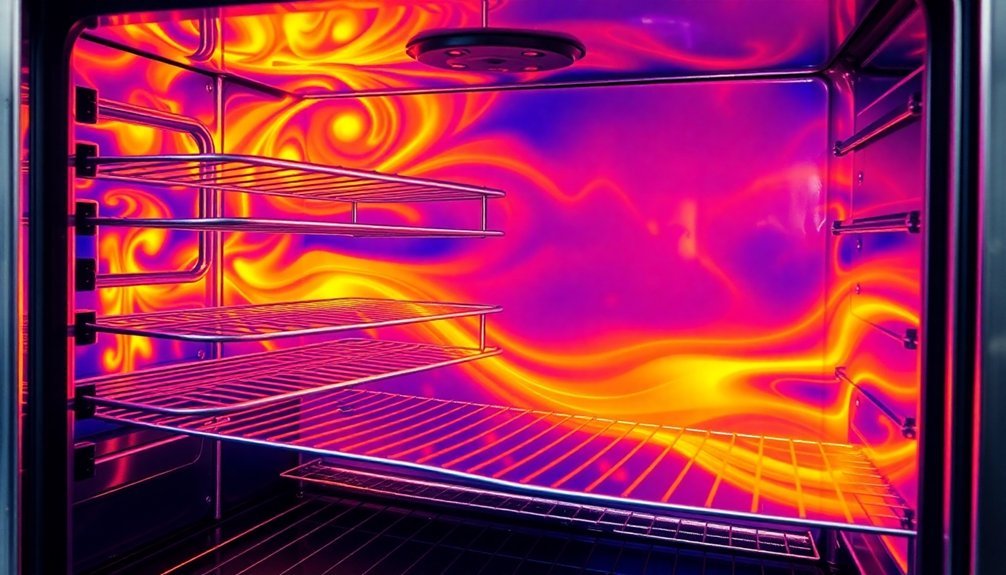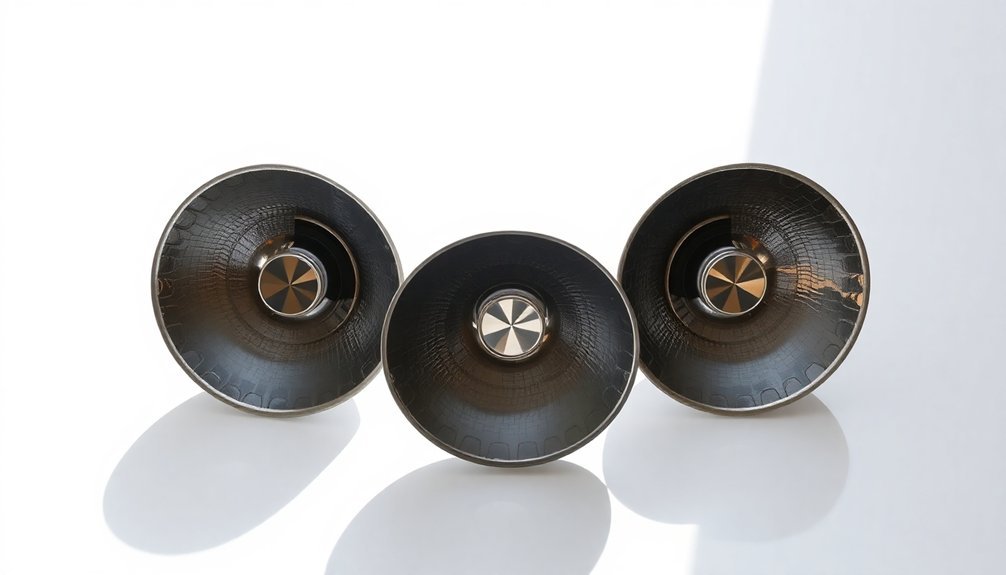You'll maximize your solar oven's morning performance by implementing these five proven preheating strategies. Start by setting up your oven before sunrise, positioning it to face east for ideal early light capture. Add extra reflective materials like aluminum foil or mirrors to boost sunlight collection. Double up your insulation using black construction paper, newspapers, and multiple layers of plastic wrap to trap heat effectively. Choose a strategic location with an unobstructed eastern view, free from building shadows and tree cover. These preparation steps will reveal the full potential of your solar cooking experience.
Start Before Sunrise

While preparing a solar oven may seem like a daytime activity, starting before sunrise is essential for maximizing your cooking time.
Begin by planning your recipes the night before, focusing on dishes that require longer cooking periods like stews or rice. Make certain you've gathered all necessary tools and ingredients in advance.
Set up your solar oven's components in a spot that'll catch the first rays of sunlight. Check that all reflectors and glass doors are clean and properly secured.
You'll want to position the oven facing east, where the sun will rise. Use aluminum foil and plastic wrap to enhance light reflection and heat retention. Allow at least one hour preheating time before adding any food to ensure optimal cooking temperatures.
Don't forget to verify the weather forecast to confirm clear skies for ideal cooking conditions. These early preparations will give you a significant head start on your solar cooking day.
Position Overnight For Morning Sun
Once you've identified the ideal cooking spot, positioning your solar oven the night before can greatly boost its morning performance.
Use a compass or sun path app to align the oven with the expected sunrise direction, and secure it firmly to prevent any wind displacement.
Make certain you've chosen a location with minimal shade and clear exposure to the morning sun. Use the T-Leg and stakes to secure your oven if winds are expected overnight.
Clean the oven thoroughly and check that it's properly sealed to retain heat. You'll want to place dark-colored cookware inside and make certain all reflective surfaces are ready to capture those first rays.
Keep the oven closed and latched overnight.
With proper positioning, you can expect temperatures to reach 300°F within 20 minutes of sunrise on a clear day, though cloudy conditions may require longer preheating times.
Use Extra Reflective Materials

To maximize your solar oven's preheating potential, adding extra reflective materials can dramatically boost its heat-gathering capabilities. You'll want to use aluminum foil, Mylar, or mirrors to direct additional sunlight into your oven chamber. Make sure you secure these materials firmly and maintain smooth surfaces for ideal reflection.
| Material | Best Practices |
|---|---|
| Aluminum Foil | Apply smoothly to flaps and interior |
| Mylar | Use on exterior surfaces |
| Mirrors | Position strategically for sun alignment |
| Multiple Reflectors | Place around oven perimeter |
| Adjustable Surfaces | Tilt for best angles |
Position your reflectors by standing behind the oven and adjusting them every 30 minutes to maintain perfect sun alignment. Larger reflective surfaces will capture more sunlight, so don't be afraid to go big with your reflector setup.
Double Layer Your Insulation
Adding a second layer of insulation creates a dramatic difference in your solar oven's heat retention capabilities.
Start by placing black construction paper at the bottom of your cooking area to maximize heat absorption. Then, wrap crumpled newspapers around the cooking cavity, followed by a layer of aluminum foil as a radiant reflector.
You'll want to guarantee your double-layer insulation surrounds all sides except the glazed top, where you can use clear plastic wrap or glass to create an effective barrier. Using two layers of plastic wrap, one on the top and one on the bottom side of the lid, ensures optimal heat retention.
For even better results, you can add materials like feathers, spun fiberglass, or rockwool between the layers. This enhanced insulation system can help your oven reach temperatures up to 200°F and maintain consistent heat for several hours of cooking time.
Choose Strategic Morning Location

Since proper positioning is vital for effective preheating, selecting your solar oven's morning location requires careful consideration.
You'll want to scout an area that receives unobstructed sunlight from sunrise onward, guaranteeing maximum heat absorption during the pivotal preheating period.
Position your oven where it won't be affected by shadows from buildings or trees throughout the morning hours.
- Place your oven in an elevated spot with a clear view of the eastern horizon
- Check the area for potential shadow patterns that could interfere with sunlight
- Choose a location that allows you to easily adjust the oven's position every 30 minutes
- Ascertain the spot has enough space for additional reflective surfaces if needed
- Select a stable, level surface that won't be disturbed by wind or movement
Frequently Asked Questions
Can I Preheat My Solar Oven on Cloudy Mornings?
It's not recommended to preheat your solar oven on cloudy mornings since it won't heat efficiently. If you need to cook, you can use fire pellets as a backup heating source in emergency situations.
How Do Weather Conditions Affect Early Morning Preheating Temperatures?
Your solar oven's preheating temps are highest in clear skies (300-400°F), reduced in cloudy conditions (200-250°F), and can be affected by wind. You'll need direct sunlight and minimal cloud cover for ideal heating.
Should I Remove Moisture From the Oven Chamber Before Morning Preheating?
You don't need to remove moisture before morning preheating – it's not significant enough to impact early temperatures. Just let the sun naturally evaporate any condensation as the oven warms up during preheating.
Does Altitude Impact Early Morning Solar Oven Preheating Efficiency?
Yes, altitude affects your solar oven's morning preheating. You'll get more intense sunlight at higher elevations, but colder temperatures and thinner air mean you'll need better insulation to maintain efficient heat buildup.
What's the Minimum Ambient Temperature Needed for Effective Early Morning Preheating?
You'll need at least 50°F (10°C) ambient temperature for effective early morning preheating. While you can start at 40°F (4°C), you'll experience markedly reduced efficiency and longer preheating times.
In Summary
You've learned five essential techniques to get your solar oven ready before the sun's at its peak. By starting early, positioning strategically, adding reflectors, boosting insulation, and finding the right spot, you'll maximize your cooking time and efficiency. Don't let cool mornings stop you from solar cooking – these methods will help you harness the sun's energy from the moment it rises.





Leave a Reply